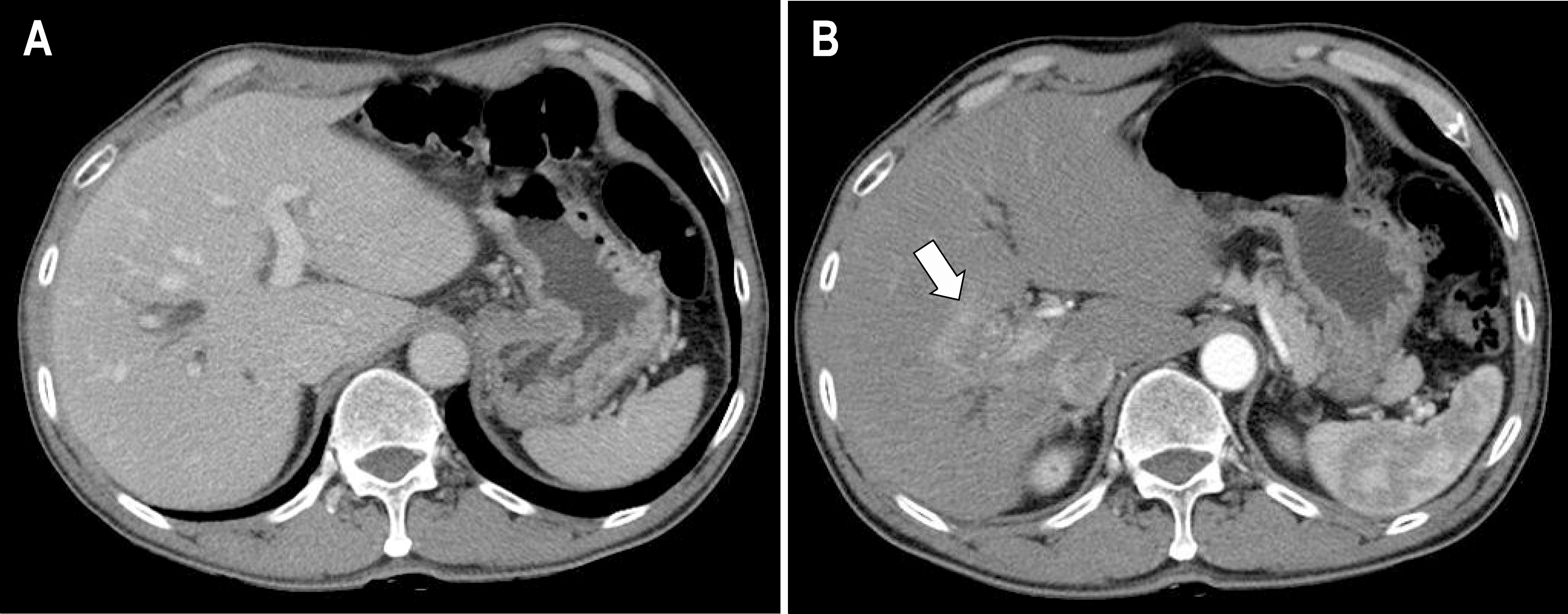Abstract
Xanthogranulomatous cholecystitis (XGC) is an unusual and destructive inflammatory process that is characterized by thickening of the gallbladder (GB) wall with a tendency to adhere to neighboring organs. XGC is often mis-taken for GB carcinoma, and the frequency of the coexistence of these two lesions is approximately 10%. Therefore, in case of severe XGC, there is chance of either overlooking the carcinoma or other significant lesions. CA 19-9 is commonly measured in the serum of patients with hepatobiliary malignancies. Although CA 19-9 can be elevated in benign conditions such as cholestasis, pancreatitis, tuberculosis, thyroid disease etc., malignancy should be considered at first in setting of its significant and persistent elevation. We report a case of a 62-year-old man who showed continuously rising level of CA19-9 over 2000 U/mL after cholecystectomy for xanthogranulomatous cholecystitis and finally was diagnosed as cholangiocarcinoma by short-term follow up.
REFERENCES
1. Lee KC, Yamazaki O, Horii K, et al. Mirizzi syndrome caused by xanthogranulomatous cholecystitis: report of a case. Surg Today. 1997; 27:757–761.

2. Benbow EW, Taylor PM. SSimultaneous xanthogranulomatous cholecystitis and primary adenocarcinoma of gallbladder. Histopathology. 1988; 12:672–675.
3. Kim JE, Lee KT, Lee JK, Paik SW, Rhee JC, Choi KW. Clinical usefulness of carbohydrate antigen 19-9 as a screening test for pancreatic cancer in an asymptomatic population. J Gastroenterol Hepatol. 2004; 19:182–186.

4. McCoy JJ Jr, Vila R, Petrossian G, McCall RA, Reddy KS. Xanthogranulomatous cholecystitis. Report of two cases. J S C Med Assoc. 1976; 72:78–79.
5. Kwon AH, Matsui Y, Uemura Y. Surgical procedures and histopathologic findings for patients with xanthogranulomatous cholecystitis. J Am Coll Surg. 2004; 199:204–210.
6. Seo SH, Park JI, Kim JS, Kim KH, Choi CS, Choi YK. Xanthogranulomatous cholecystitis: a retrospective analysis of 36 cases. J Korean Surg Soc. 2009; 76:371–377.

7. Song SH, Nam SW, Roe IH, et al. A clinical analysis on patients with xanthogranulomatous cholecystitis. Korean J Gastroenterol. 2003; 41:133–137.
8. Pinocy J, Lange A, Kö nig C, Kaiserling E, Becker HD, Krö ber SM. Xanthogranulomatous cholecystitis resembling carcinoma with extensive tumorous infiltration of the liver and colon. Langenbecks Arch Surg. 2003; 388:48–51.

9. Enomoto T, Todoroki T, Koike N, Kawamoto T, Matsumoto H. Xanthogranulomatous cholecystitis mimicking stage IV gallbladder cancer. Hepatogastroenterology. 2003; 50:1255–1258.
10. Spinelli A, Schumacher G, Pascher A, et al. Extended surgical resection for xanthogranulomatous cholecystitis mimicking advanced gallbladder carcinoma: a case report and review of literature. World J Gastroenterol. 2006; 12:2293–2296.

11. Goonetilleke KS, Siriwardena AK. Systematic review of carbohydrate antigen (CA 19-9) as a biochemical marker in the diagnosis of pancreatic cancer. Eur J Surg Oncol. 2007; 33:266–270.

12. Steinberg W. The clinical utility of the CA 19-9 tumor-associated antigen. Am J Gastroenterol. 1990; 85:350–355.
13. Mann DV, Edwards R, Ho S, Lau WY, Glazer G. Elevated tumour marker CA19-9: clinical interpretation and influence of obstructive jaundice. Eur J Surg Oncol. 2000; 26:474–479.

14. Ong SL, Sachdeva A, Garcea G, et al. Elevation of carbohydrate antigen 19.9 in benign hepatobiliary conditions and its correlation with serum bilirubin concentration. Dig Dis Sci. 2008; 53:3213–3217.

15. Clarke T, Matsuoka L, Jabbour N, et al. Gallbladder mass with a carbohydrate antigen 19-9 level in the thousands: malignant or benign pathology? Report of a case. Surg Today. 2007; 37:342–344.

16. Kim BJ, Lee KT, Moon TG, et al. How do we interpret an elevated carbohydrate antigen 19-9 level in asymptomatic subjects? Dig Liver Dis. 2009; 41:364–369.

Fig. 1.
Preoperative gallbladder CT findings. (A) Approximately 8×5.1 cm sized heterogeneously enhancing mass with invasion to adjacent liver (segment 5/6) on gallbladder bed and overt peritoneal seeding and invasion or adhesion to adjacent colon. (B) Mild dilatation of both right and left intrahepatic bile ducts was seen.

Fig. 2.
Pathologic findings of xanthogranulomatous cholecystitis. (A) Gross features of the resected gallbladder. Note whitish yellow and thickened wall, up to 4 cm in wall thickness. (B-D) Microscopic features. (B) Mucosa was hemorrhagic and ulcerated, and wall was fibrotic (H&E, ×40). (C) Inflammatory cells heavily infiltrated in fibrotic stroma (H&E, ×200). (D) Numerous foamy histiocytes were ad-mixed with various inflammatory cells (H&E, ×400).

Fig. 3.
Postoperative abdominal CT findings. (A) Mild dilatation of both right and left intrahepatic bile ducts considering postoperative change was seen. (B) An overtly enlarged mass with infiltration in right hepatic lobe (about 3.8 cm) was seen (arrow).

Fig. 4.
Pathologic findings of adenocarcinoma. (A) Gross feature of the resected liver and intrahepatic bile duct. Note a whitish gray mass lesion at intrahepatic bile duct with invasion into liver. (B-D) Microscopic features. (B) Moderately differentiated, malignant gland formation was observed in bile duct. The uppermost surface of mucosa was totally denuded (H&E, ×40). (C) High power of B (H&E, ×200). (D) It showed that adenocarcinoma (left upper portion) invaded normal liver parenchyma (right lower protion) (H&E, ×100).





 PDF
PDF ePub
ePub Citation
Citation Print
Print


 XML Download
XML Download